
5 minute read
Tread lightly – and live well
T R E A D L I G H T L Y AND LIVE WELL
Planned into the very heart of Onekiritea-Hobsonville Point, the sustainable development framework was created to protect the environment and enhance the lives of the people who live here.
Advertisement
Design and construction, waste, water and energy management, how residents interact with each other and their environment, public transport and safety – the Onekiritea-Hobsonville Point Sustainable Development Framework sets out practical ways to build a strong, vibrant community.
And practicality is key. Real sustainability is holistic and includes our social and cultural needs as well as care for the environment. That’s why the framework is both a founding vision and an ongoing way of measuring the success of the development.
So how do the four sustainability spheres of the framework make a difference to the everyday lives of Hobsonville Point residents?
ENVIRONMENTAL ENHANCEMENT
To help protect and increase biodiversity, a continuous vegetation corridor covers 10% of Hobsonville Point. More than 10,000 locallysourced native plants have been grown here – you can see many of them along the coastal edge.
The plants increase native biodiversity and enhance the beauty of the popular coastal walkway – all while reducing erosion by acting as a buffer between land and sea. And to protect the sparkling Waitematā Harbour, stormwater at Hobsonville Point is processed using a ‘treatment train’, which ensures the water entering the harbour is as clean as possible.
Lowering that carbon footprint by using public transport is easy here, with 100% of dwellings within 800m of a bus stop. People who work in the CBD can also leave the car at home and take the daily ferry service from Catalina Bay.


What’s more, the locals of Hobsonville Point take the time to care for their neighbourhood, with nearly 70% taking action to help improve the natural environment.
ECONOMIC CARE
The homes here are quality, with better insulation and double glazing than the New Zealand Building Code requires. The use of concrete slabs as part of the building construction creates passive heating – which means in the winter you don’t need to heat your home as much by artificial means, saving money and energy.
Homes are fitted with dual flush toilets and low-flow showers and taps. Outside, 3000-litre rainwater tanks provide for tasks like doing laundry and watering the garden. As a result, Hobsonville Point residents use 25% less energy and 32% less water than the Auckland average.
An important aspect of the plan for Hobsonville Point is to deliver quality, healthy homes to the hungry Auckland housing market – and do it as soon as possible. Now, more than one new house is built every day at Hobsonville Point, and 20% of all homes will be in a more affordable price range. And, just so you know, 85% of building waste is recycled.
Landscaping guidelines require the use of plenty of native plants

CULTURAL DEPTH
Partnership with Ngāti Whātua o Kaipara and Te Kawerau a Maki helps to ensure that the history of Onekiritea-Hobsonville Point is preserved. And not only preserved, but that the whakapapa of the whenua and the natural ecosystems in the environment is restored and amplified.
The whakapapa of Onekiritea is woven into the neighbourhoods through place names drawn from mana whenua and the community. There’s at least one public artwork in each precinct, and oral and written histories captured and displayed at points of interest throughout the development.
At every turn, the past is reflected in the overall design of Hobsonville Point, which ensures that its history remains a part of its future. For example, the section of the walkway between Catalina Bay and Bomb Point has been deliberately disrupted by mata (eye), circular landscape features. These draw on the Māori concept of whakarare, meaning to ‘distort’ and provide opportunities to pause, notice the landscape or to rest a while.

SOCIAL CONNECTION
Hobsonville Point is a great place to live and the Point’s sustainable development framework report shows that 93% of residents agree. It’s a place where neighbours know each other and kids can play unsupervised in public spaces.
The report shows 95% of people have positive contact with neighbours – and this isn’t only because locals are friendly. Encouraging diversity through the physical design of the buildings and connecting spaces has been a guiding principle. Public spaces are close to people’s homes, like an extension of their backyards. The 5km Coastal Walkway also provides a safe, car-free space for pedestrians and cyclists. The walkway connects land to sea and passes through several neighbourhoods including the food, beverage and business precinct at Catalina Bay – 90% of residents say they shop locally.
The former aircraft hangars and heritage buildings are available for community use. In fact, 71% of residents feel a sense of community at Hobsonville Point, with more than half participating in community activities.
HAPPY 10TH ANNIVERSARY
Right from the start Hobsonville Point has been forward thinking, shaping a practical framework for sustainable development.
The Onekiritea-Hobsonville Point Sustainable Development Framework is celebrating 10 years since it was set out – and it continues to be fundamental to the delivery of the project.
The framework aims “To build a strong, vibrant community that sets new benchmarks for quality and accessible urban development with an environmentally responsible focus.”
Progress of the development is continually measured against the framework, using results from the annual residents’ survey as well as Vector and Watercare data. Many of the objectives are intentionally ambitious, but the development is meeting and even exceeding those objectives.
Find the sustainability report at
hobsonvillepoint.co.nz
A natural way of processing stormwater, the swales at Hobsonville Point double as wetlands for birds










